The Magnet Lab's Cryogenics group does research and development to advance the field and support technology.
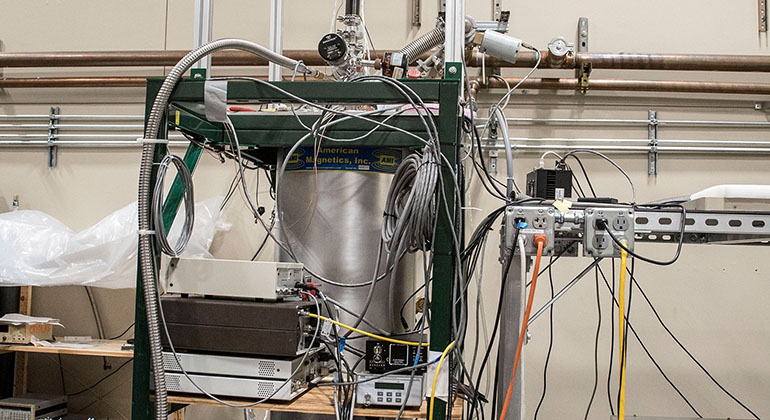
A systematic study of the decay of quantum turbulence in the wake of a towed mesh grid.
Turbulence in fluids is one of the most common phenomena of nature occurring on scales ranging from your ordinary teacup to swirling gas nebulae of galactic proportions. Our goal is to investigate this common, yet so-far poorly understood, behavior in an uncommon medium: superfluid helium whose flow is strongly influenced by quantum mechanical properties.
There are many possible approaches to experimental studies of turbulence. The one employed in this project is a staple of classical turbulence research: decaying turbulence is probed in the wake of a uniform grid, which, in our case, is towed through a square channel. We visualize the flow using fluorescence of metastable Helium molecules, a novel technique recently developed in this laboratory. Using this technique we are able to extract information on velocity (of the normal component of superfluid Helium) on a range of scales and decay times. The obtained information allows, among other things, study various statistical properties of the flow.
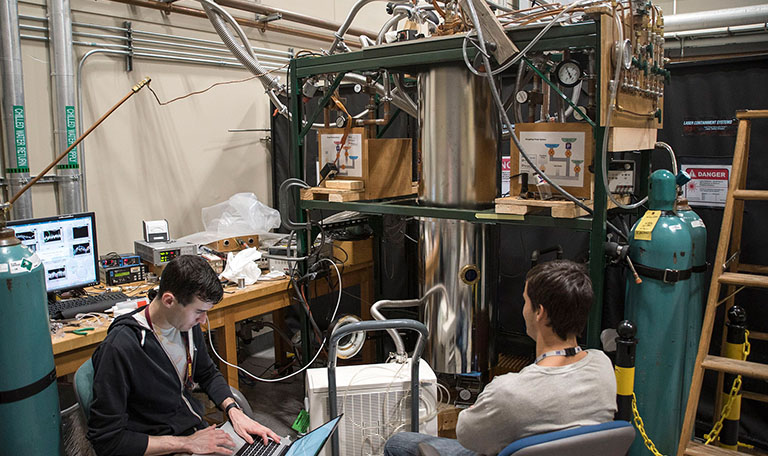
Low Gravity Simulator apparatus

Low gravity simulator schematic
A planned study of the evolution of the quantized vortex tangle in a levitated liquid helium droplet.
The objectives of this project include a thorough investigation of how the appearance of vortices can affect the stability of a rotating superfluid drop and an in-depth study of the evolution of a vortex tangle in a wall-free environment. This study will improve our understanding of superfluid drop morphology and will advance our knowledge of the turbulence dissipation mechanism in pure superfluid.
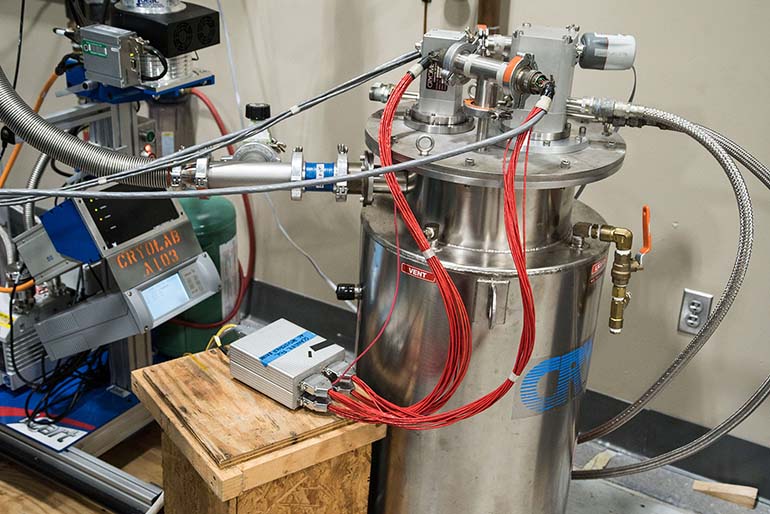
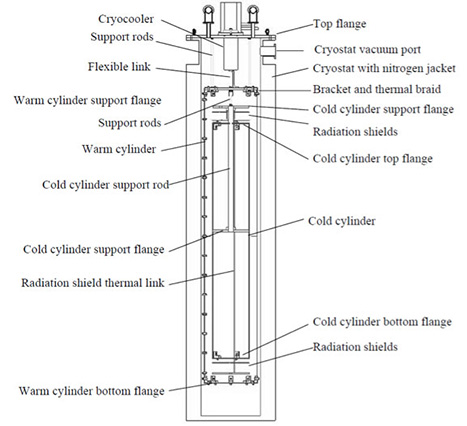
Investigation of the performance of multi-layer insulation for space-based applications.
The Multi-layer Insulation Thermal Conductivity Experiment measures the thermal performance of multi-layer insulation (MLI). This lightweight insulation is composed of alternating thin reflective layers with insulating layers and is used as a high performance insulation for spacecraft, cryogen storage tanks, MRI's, and space-borne instruments.
![]()
A study of thermally and mechanically generated turbulence in He II using traditional velocimetry techniques.
With this experiment we study turbulence in He II using direct flow visualization and second sound attenuation. The characteristics of thermally generated flow are important since He II is used as a coolant for superconductors and spacebased instrumentation. Researchers are interested in understanding mechanically generated turbulence in cryogenic helium because this fluid has low kinematic viscosity, which may allow it to emulate large scale flow in a compact and efficient laboratory setting.
This experiment is conducted in a 13 in. long transparent vertical flow channel with 5/8 x 5/8 in. cross section submersed in a helium cryostat with optical access. Flow can be generated using the heater at the bottom of the channel or by towing a mesh grid (mesh number M = 3, 3.75, or 5 mm) through the channel at speeds up to 1 m/s. Images of the resulting flow can be captured at a rate up to 120 frames per second.
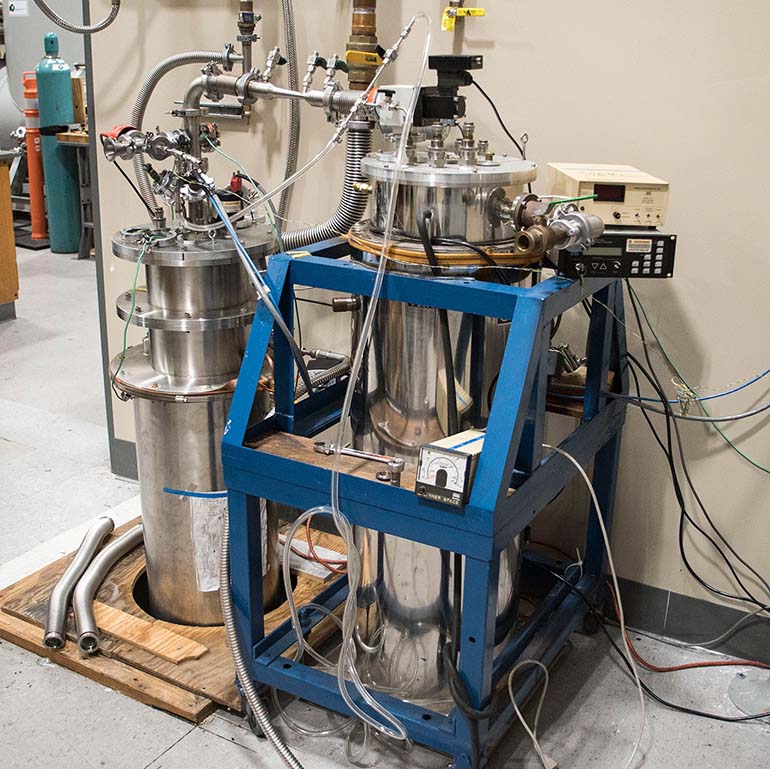
Sudden Loss of Vacuum apparatus
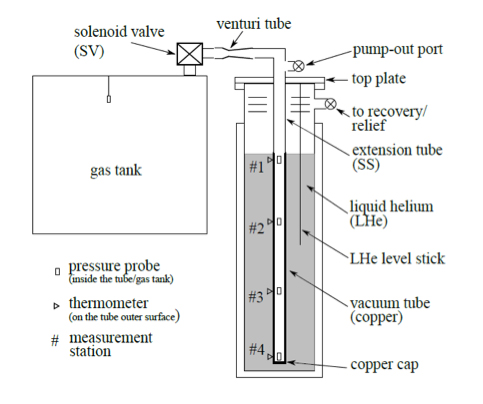
Sudden loss of vacuum schematic
In this experiment we simulate the sudden loss of vacuum inside a liquid helium cooled superconducting radio frequency (SRF) cavity string
Modern linear particle accelerators (LINAC) for high energy physics research use superconducting radio frequency (SRF) technology with liquid helium (LHe) cooling. The SRF beam-line or the ‘cavity string’ of such a LINAC is essentially a long high vacuum channel immersed in LHe with interconnects near the atmosphere. Accidental loss of the beam-line vacuum to the atmosphere, say due to a rupture, is perceived to be catastrophic as the rupture will expose the LHe enclosed vacuum space to the warm atmospheric air. The air rapidly flowing in from the local rupture will propagate down the vacuum space, and on condensation on the cold beam-line, will transfer large heat fluxes to the LHe. Our research on this subject has mainly focused on understanding how in the presence of condensation, the in-flowing air will propagate down the vacuum space. The scenario is studied by venting near-atmospheric nitrogen gas (a substitute for air) to a vacuum tube immersed in a LHe bath and then measuring the gas front propagation speed along the vacuum tube.
So far we have experimented with and have characterized the gas propagation in a straight long 1.5 inch outer diameter tube, 1.5 meter long and immersed in 4.2 K liquid helium. Future activities include development of apparatus and detailed parametric experiments with 2 K superfluid helium (He II) coolant.
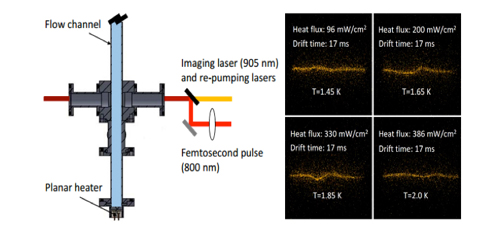
A systematic study of the normal fluid motion and quantized vortex line density in steady-state and decaying thermal counterflow in He II.
Superfluid helium-4 (He II) has been widely used as a coolant in many engineering applications. Investigating the heat induced flow in He II can help engineers design a better cooling system. A novel flow visualization technique based on laser induced fluorescence of thin lines of the metastable He2 triplet molecules has been developed in our lab. Combining flow visualization and second sound attenuation measurements allow us to study the heat induced flow and its decay in He II.
Last modified on 29 December 2022